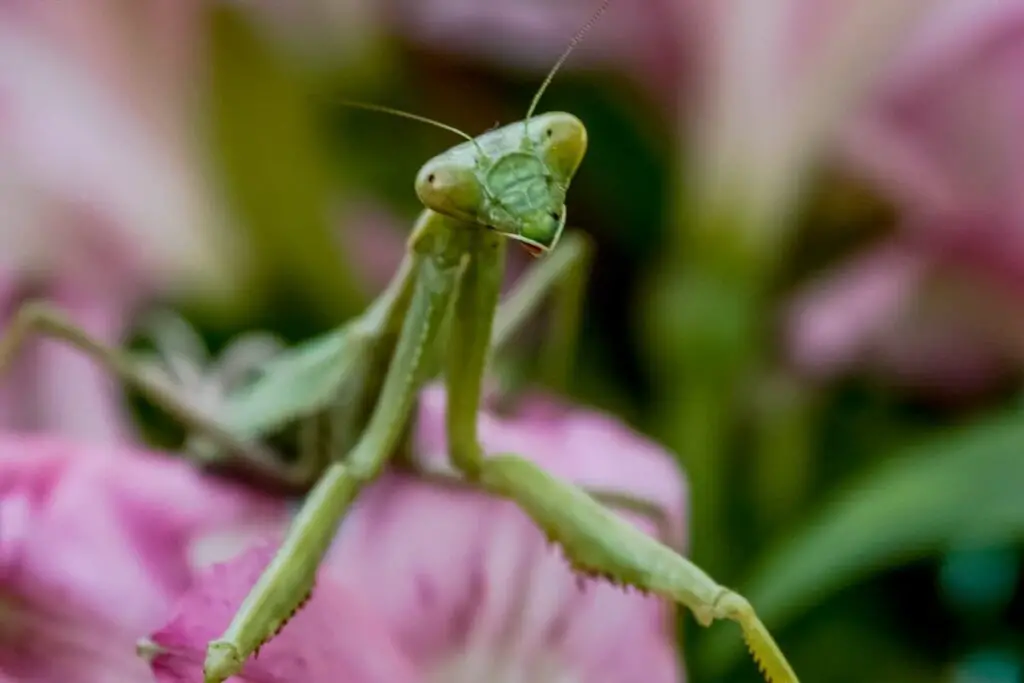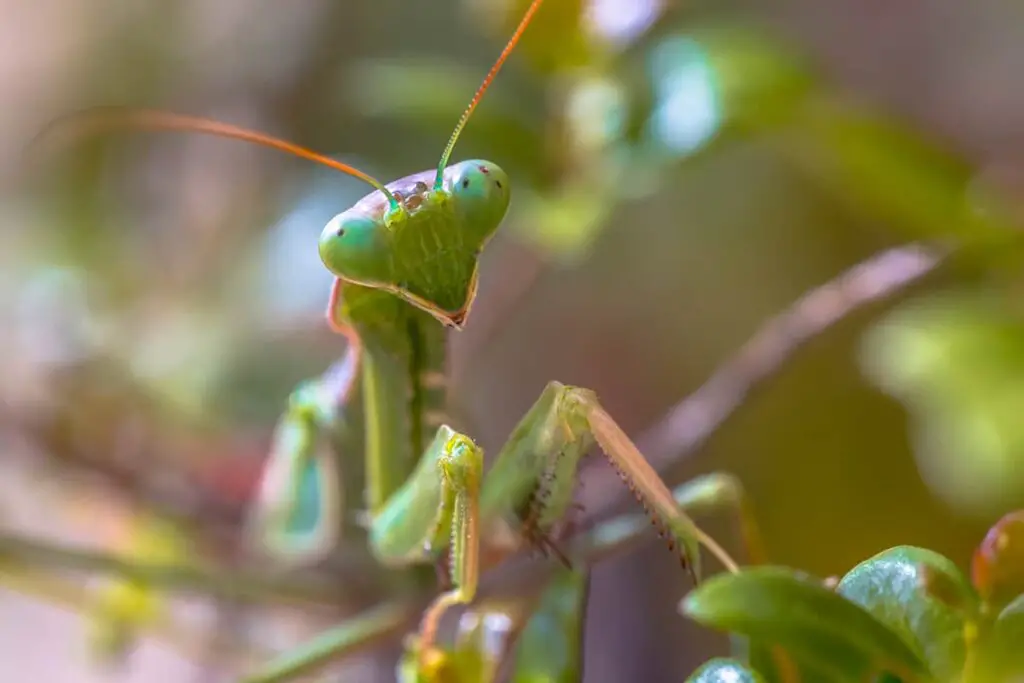Caring for a praying mantis offers a unique peek into the fascinating world of insects, particularly when it comes to their diet. Understanding the nutritional needs of your mantis can significantly enhance its health and vitality. Whether your mantis is a voracious juvenile or a majestic adult, it requires specific types of food to thrive.
Your mantis’s diet isn’t set in stone and will change as they grow. When they’re young, they need frequent meals of small prey, while adults may eat less often but consume larger food items. The key is to provide a variety of prey that helps mimic their natural hunting experiences.
Overfeeding and underfeeding can both pose risks, so it’s best to tailor the feeding schedule to your mantis’s species and size. A general guideline is offering prey roughly half the size of your mantis, while ensuring not to give prey that is too large for your pet to easily manage. By observing and responding to your mantis’s behavior and appetite, you’ll be well on your way to keeping a healthy and happy insect companion.
Understanding Mantis Nutritional Needs
To ensure your mantis thrives, it’s essential to understand their dietary requirements which vary through their life stages and include a balance of macronutrients and essential vitamins and minerals.
Macronutrient Balance
- Proteins: The cornerstone of a mantis diet, necessary for growth and development. Offer a variety of insects such as fruit flies for nymphs and larger prey like moths for adults to mimic their natural prey selection.
- Carbohydrates & Fats: Although less critical, they’re still important for energy. Most insects you feed your mantis provide these nutrients.
Essential Vitamins and Minerals
- Calcium & Phosphorus: Vital for molting and exoskeleton development. Feeding your mantis with gut-loaded insects (insects fed nutritious foods before being offered as prey) can help meet these mineral needs.
- Vitamins: A to Z vitamins are crucial, especially Vitamin A for vision and other physiological functions. Your mantis will get most of what they need from a diverse diet of well-nourished prey.
Feeding Schedules and Portions
When you’re creating a feeding schedule for your mantis, it’s important to consider their life stage. Adult mantises typically only need to eat once every two to three days, while nymphs (younger mantises) may require more frequent feedings due to their rapid growth.
Here are a few guidelines to help you determine how much to feed:
- Nymphs: daily or every other day.
- Adults: once every 2-3 days.
Regarding the size of the portion, a good rule is:
- Nymphs: Insects around 1/4 their size.
- Adults: Prey about half the size of the mantis.
It’s key to watch your mantis after feeding. If its abdomen is swollen, it’s a sign it’s well-fed, so you can adjust accordingly for next time.
| Life Stage | Frequency | Portion Size |
|---|---|---|
| Nymphs | Daily | 1/4 the size of your mantis |
| Adults | Every 2-3 days | 1/2 the size of your mantis |
Remember to adjust the feeding based on the size and species of your mantis. Some mantises may have slightly different requirements; it’s always best to observe and adjust.
Keep in mind that overfeeding can be harmful; mantises are adept at fasting, so there’s no need to worry if you skip a day. Feeding time is also an excellent opportunity to bond with your mantis and observe its unique hunting behaviors.
Discover more on the nutritional needs of mantises across their life cycle, or learn about what and how mantises eat including feeding tips and appropriate portion sizes.
Choosing Quality Feed
Providing your mantis with the right nutrition is crucial for its health and longevity. The choices you make in food selection can significantly impact your pet’s well-being.
Live Prey Selection
- Variety is Key: To ensure your mantis gets a balanced diet, offer a range of live prey, such as fruit flies, roaches, and small crickets. Each type of insect offers different nutrients, making variety essential. For example, fruit flies are often recommended for younger or smaller mantids due to their size.
- Appropriate Sizing: The prey you provide should not be too large for your mantis to handle. A good rule of thumb is that the prey’s size should be no more than one-third of your mantis’s length.
Commercial Mantis Diets
- Supplemental Feeding: Although live prey should make up the majority of your mantis’s diet, commercially available mantis diets can serve as supplements. Make sure to choose high-quality products designed specifically for mantids.
- Nutritional Content: Check the labels for nutritional content, ensuring that the products supplement the live diet and do not contain fillers or inadequate nutrients. Your mantis will thrive on a balanced diet fortified with necessary vitamins and minerals.
Safe Feeding Practices and Hygiene
When you’re feeding your mantis, there are some key practices to ensure the health and safety of your pet as well as hygiene in the process.
Proper Food Size: It’s important that the insects you feed your mantis are not too large. Ideally, the prey should be no more than one-third the size of your mantis to prevent injury or feeding difficulties.
Feeding Frequency: Young mantises require frequent feedings, sometimes as much as 2-5 times a day depending on their size and species. Check out feeding younger mantises for more details on early-stage care.
Feeder Insect Variety: Offer a variety of insects to provide a balanced diet, such as cockroaches, flies, and mealworms. However, mealworms should be treated as occasional treats rather than a staple.
Hygiene:
- Always wash your hands before and after feeding your mantis.
- Clean any feeding utensils or dishes regularly to prevent the build-up of bacteria.
Preparing Feeder Insects:
- If feeding frozen insects, ensure they are thoroughly defrosted.
- Dust your feeder insects with a calcium supplement periodically to support the nutritional needs of your mantis.
Avoid Contaminants: Be cautious of where you source your feeder insects. They should be free from pesticides and other harmful chemicals which could be detrimental to a mantis’s health.
By following these simple guidelines, you can help your praying mantis thrive with a healthy diet and a clean environment.
Frequently Asked Questions
Ensuring your praying mantis receives the right nutrients is essential for its health and well-being. Here’s a quick guide to commonly asked questions about mantis nutrition.
What should I feed my praying mantis?
Your praying mantis thrives on a diet of live insects such as crickets, moths, and flies. Larger species may also consume small vertebrates. Live prey is critical as it encourages the natural hunting behavior of the mantis.
How often should a praying mantis be fed?
Adult mantises should be fed every 2-3 days, while nymphs require feeding more frequently, about every day or two, due to their higher metabolic rate and growth demands.
Are there any recommended foods for baby praying mantids?
Baby praying mantids, or nymphs, do well with smaller prey such as fruit flies and other tiny insects that they can easily capture and consume.
Can a praying mantis eat fruit, and if so, which kinds?
While praying mantises primarily eat other insects, some mantis keepers have observed their pets accepting small pieces of soft fruit like bananas or peaches. However, fruits should not be a significant part of their diet.
Is it possible to overfeed a praying mantis?
Yes, it is possible to overfeed a praying mantis, especially if it’s provided with more food than it can consume in one sitting. Overfeeding can lead to health issues, so it’s important to offer appropriate portions.
What are some common feeding strategies for a praying mantis?
A common strategy is to simulate prey movement by gently shaking the prey item in front of the mantis to trigger its hunting instinct. Additionally, make sure to remove uneaten prey to prevent stress and potential harm to your mantis.
Driven by a passion for those tiny creatures that rule our world, we at Bug Domain strive to be your go-to resource for information on insects.



